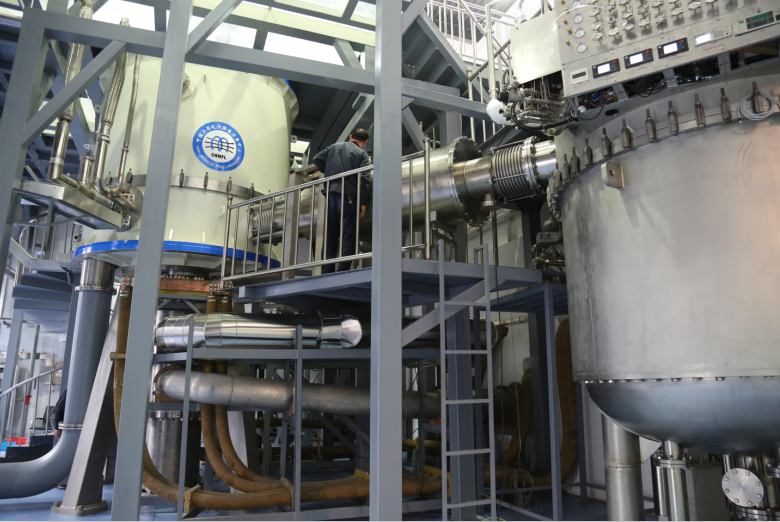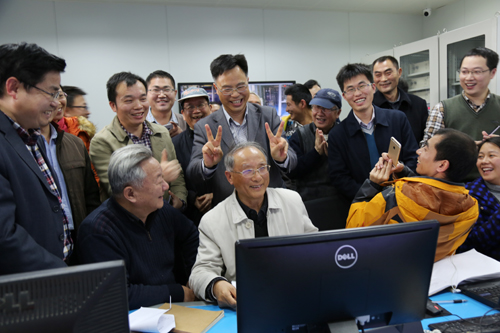Nov. 13th is a monumental day for the High Magnetic Field Laboratory of Chinese Academy of Sciences (CHMFL) as the commissioning of the hybrid magnet achieved great success. The self-designed and self-built hybrid magnet reaches its premier goal of 40-Tesla and becomes the second strongest steady field magnet in the world.
Hybrid magnet fuses two types of magnet-making technologies: superconducting and resistive. The 40 Tesla hybrid magnet is composed of a 30 Tesla resistive magnet nested in a 10 Tesla superconducting magnet outsert.
The 30-Tesla “insert”, a resistive magnet with a 32 mm room temperature bore developed by CHMFL, was tested and reached the goal of 30 Tesla central field by itself in September, 2016.
The 10-Tesla “outsert”, a superconducting magnet with a tremendous 920mm bore was tested and reached the goal of 10 Tesla on November 5th, 2016.
The successful assembly of the two magnets reached the full field of 40 Tesla, which is a dream come true for everyone in CHMFL after eight years of planning, designing and building!
High magnetic field is an extreme experimental condition to explore the frontiers of science. The higher the magnetic field, the more the opportunities to new discoveries. So the development of magnet science is inevitably on the way to produce stronger magnetic fields.
The pursuit of extremely high magnetic fields is like climbing Mount Everest: before reaching the limit, you’ll need to overcome many difficulties on the way to success.
Hybrid magnet is currently the primary instrument to produce very high steady magnetic fields. “We faced a series of technical challenges,” said GAO Bingjun, the Chief Engineer at CHMFL, “for example, the optimal selection of materials and structures of the two magnets, the problem of huge electromagnetic force and severe overheating, the production technology, and the related cryogenic cooling technology. The high stability power supply system at ten million watt level is a major challenge by itself.”
Additional difficulties lie in the seemingly simple assembly process, i.e. the perfect alignment of the central plane and magnetic axis of the two magnets. The misalignment of one millimeter will cause tons of interaction force between the two magnets. A miss is as good as a mile.
Nevertheless, CHMFL rises to all challenges and achieves great success in the 40 Tesla hybrid magnet. High field magnetic technology used to be a weak point in China. “The success reflects tremendous improvement of high field magnet technology in China,” said KUANG Guangli, dircetor of CHMFL. It is indeed a milestone for the development of high field magnet technology.
It is reported that the newest magnet will be used mainly in quantum behavior research of new materials.
The 40 Tesla hybrid magnet is the last and strongest member among the nine magnets of CHMFL’s Steady High Magnetic Field Facility (SHMFF) project of Chinese National 11th Five-Year Major Science and Technology Infrastructure.

Test results of the 40T hybrid magnet (10T superconducting magnet outsert and 30T resistive magnet insert) (Image by ZHANG Jun)

The Hybrid magnet (Image by SUN Ce)

Centre control room (Image by SUN Ce)
Contact:
KUANG Guangli
High Magnetic Field Laboratory,
350 Shushanhu Road, Hefei, Anhui, P. R. China, 23003
Tel: 86-551-65595686
Email: kuang_gl@ipp.ac.cn
 Tel: +86-551-65591206
Tel: +86-551-65591206
 Fax: +86-551-65591270
Fax: +86-551-65591270
 Emai: zhous@hfcas.ac.cn
Emai: zhous@hfcas.ac.cn
 350 Shushanhu Road
350 Shushanhu Road